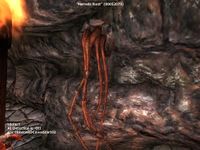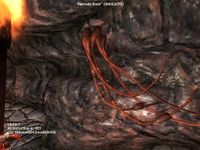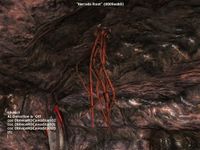Oblivion talk:Harrada
Pictures[edit]
There are 5 pictures of the harrada but 4 of them say they can attack you. It should only be 4 pictures and 2 should not be able to attack you. 128.227.142.135 14:08, 27 October 2007 (EDT)
- Technically that is true. In the Construction Set one can find 4 types of Harrada Roots. Two types have an attack script, and two don't (the "Hanging" types). This used to be as it was documented on this page. The reason that it was replaced with the current explanation is because the situation found in the CS is deceiving, and will confuse many readers (as hanging varieties found in caves do attack). The reasoning on the resultant 5 varieties goes as follows:
- You start with the four types found in the CS. However, the two "Hanging" types you can find there look very similar (one type has a few more roots in width than the other type), so it would only have been necessary to have a picture of one.
- Then, the two attacking types are also found in caves, but there they have been rotated. They appear to be the different, but are in nature the same as the two varieties found outside. In this case it was easier to present them as seperate varieties, as the average player isn't aware of how the game mechanics work.
- This results in the 5 displayed varieties. If you look at the image names, you can see they hold true to this reasoning.
- I admit the end result is confusing for people familiair with the Construction Set, and I realise now I should have posted an explanation on the talk page when I added the images. --Timenn 15:35, 27 October 2007 (EDT)
Harrada Cave varieties[edit]
In case the above explanation may not have been adequate enough, and in reference to the verification-needed tag placed on the fourth image, here are some images that should indicate that the variety shown on the fourth image does attack.
Apologies for the Torch, but that one was needed for good lighting.
If you check the FormID's in the console, and use the CS to look up their type, you will see that the variety in the first two images is different from the variety in the third image. The first variety was captured in OblivionRDCavesStart02, the second in OblivionRDCavesStart03.
Yes, the second variety also attacks you, but I couldn't seem to get that one's animation captured in combination with the console opened. --Timenn 08:05, 15 November 2007 (EST)
- Thanks for the detailed reply Timenn :) I suppose my verification tag was in part wishful thinking (exacerbated by being somewhat tired at the time!), hoping that there might be some easy way to visually distinguish between the attacking and non-attacking varieties. Because as it stands, the text that I added to try clear up the confusion, namely "these varieties differ from the attacking ones in that they hang over the edge of a rock or ledge, instead of just hanging straight down," still isn't an ideal description; the HarradaGroundAttackPLANT variety doesn't hang "straight down." But I'm not sure how to further tweak the wording.... --NepheleTalk 17:58, 30 November 2007 (EST)
-
- Harrada Root isn't one of the easiest flora of Oblivion to document. :)
- What might be an idea is to seperate the description for the readers-only and people who have worked with the Construction Set. If we only explain that there exist 5 varieties, 3 outside and 2 inside caves, then only the CS people will be confused (A minority). People who are confused and go to the Discussion page, will find the a detailed explanation. Which should either satisfy them, or give an invitation to join in on the discussion. A note between html-comment tags can be added to the article for the people who are planning to alter the page right away. --Timenn < talk > 13:01, 1 December 2007 (EST)
-
-
- I'd prefer to have the detailed explanation in the article rather than just on the talk page, especially in a case when everyone is sure of the facts (IMO, talk pages are better in situations where editors aren't really sure of the details yet and need to keep track of discrepanciees or unresolved facts). But otherwise your plan sounds good. In other words, in the intro just have the basic explanation of the varieties. Then add a notes section perhaps where there's a more detailed explanation of the varieties. --NepheleTalk 00:04, 12 December 2007 (EST)
-
Harrada and Chameleon[edit]
Is it worth mentioning that harrada will strike out and try to hurt you even when you have 100% chameleon? i am not sure if this is true for spiddal sticks but this would mean haarrada's behaviour is more like some proximaty traps which activate even if they cant see you. would this make harrada's attack a kind of trap attack rather than animal attack behavior?-- Lewbot1 10:19, 8 June 2008 (EDT)
- It is a trap - note that Harrada also cannot be attacked and killed. A hostile Harrada is always hostile, and is not subject to detection rules, so it can always see you. I would say it should be added to Traps, along with Spiddal plants. --TheRealLurlock Talk 10:48, 8 June 2008 (EDT)
-
- Agreed it should be added.-- Lewbot1 12:47, 8 June 2008 (EDT)
-
-
- I disagree to be honest. The word "trap" implies conscious design - these are just plants. Chameleon and Invisibility only affect those that rely on electromagnetic radiation (light) for detection. Presumably the plants have other mechanisms - just like the Venus Flytrap. –Rpeh•T•C•E• 12:59, 8 June 2008 (EDT)
-


